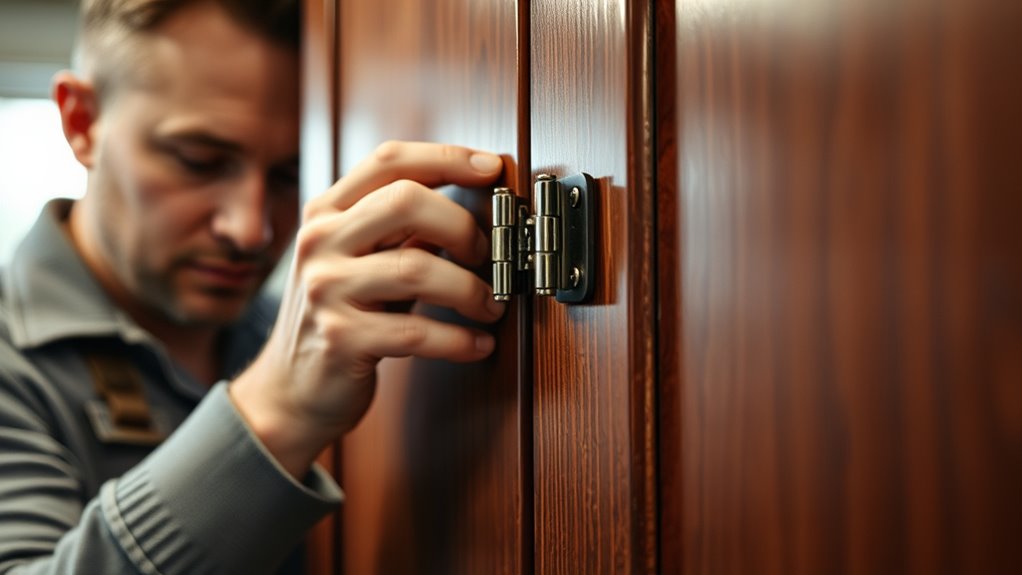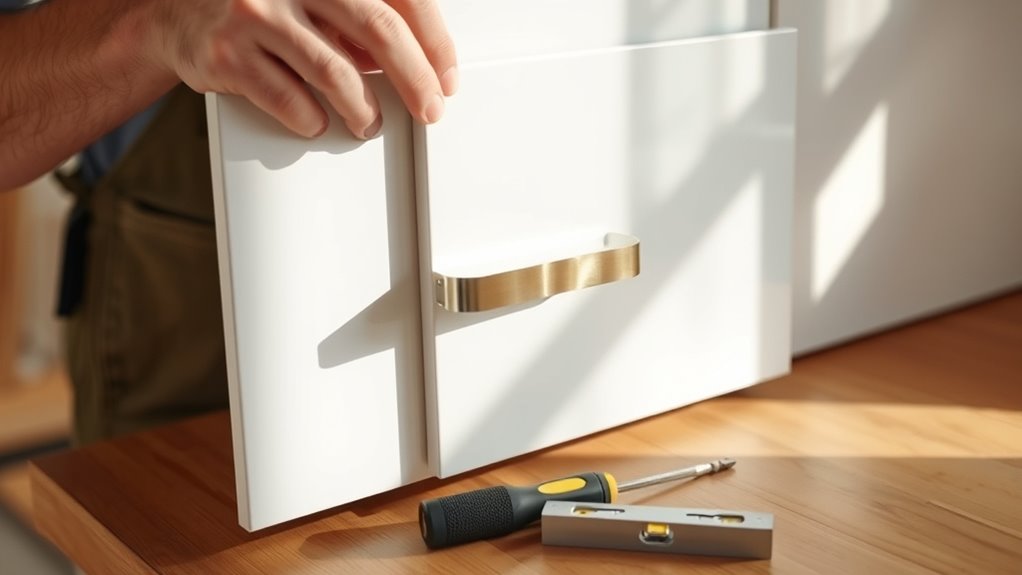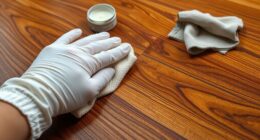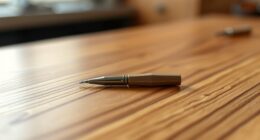If your cabinet doors won’t close properly, start by inspecting the hinges for looseness or misalignment. Use a screwdriver to tighten or adjust the hinge screws, making small, gradual changes to align the door correctly. Check for debris or damage if adjustments don’t hold, and consider replacing worn hinges if needed. Proper adjustments can fix most issues, and continuing this process will reveal even more ways to achieve perfect closure.
Key Takeaways
- Inspect hinges for wear, damage, or debris, and clean or replace if necessary.
- Fully open the door and identify which hinges need adjustment for proper alignment.
- Use screwdriver adjustments to correct vertical, side-to-side, and in/out hinge screws gradually.
- Make small, incremental adjustments, testing door closure after each to achieve proper fit.
- Check for warped doors or damaged hinges if adjustments don’t resolve the closing issue.

Have your cabinet doors started to look worn or misaligned? If they’re not closing properly or seem crooked, it’s time to take a closer look. Often, the issue isn’t with the doors themselves but with the hinges, which can become loose or misaligned over time. Fortunately, fixing this is straightforward and doesn’t require a full replacement. The key is understanding hinge adjustment and how it affects door alignment. By tweaking the hinges, you can restore your cabinet doors to their proper position, ensuring they close smoothly and look uniform.
Start by opening the door fully and inspecting the hinges. Most hinges have adjustment screws that control different planes of movement—up and down, side to side, or in and out. Using a screwdriver, gently tighten or loosen these screws. If your door is sagging downward or upward, adjusting the hinge’s vertical screw will help. For doors that are crooked or not aligned properly, side-to-side adjustment screws are your best bet. Adjust these carefully until the door sits flush with the surrounding cabinet frame or neighboring doors. For gaps that are uneven, in-and-out screws can help pull the door closer or push it away from the cabinet, achieving a tight fit.
It’s a good idea to make small adjustments gradually, checking the door’s position after each tweak. Close the door gently to see if it aligns properly with the others. If it still doesn’t sit right, revisit the hinges and fine-tune the screws. Be patient—sometimes it takes a few rounds of small adjustments to get everything perfect. Keep in mind that hinges can wear out or become loose over time, so if your adjustments don’t hold or the hinges look damaged, replacing them might be necessary. Additionally, understanding filtration systems can help identify if debris or dust accumulation is affecting hinge operation or causing misalignment.
Door alignment isn’t just about aesthetics; it can also impact how well your cabinet doors close and latch. Properly aligned doors won’t catch or slam shut unexpectedly. If your cabinet doors still won’t close after adjusting the hinges, look for other issues like warping or swelling of the wood, or debris blocking the latch mechanism. Sometimes, a simple hinge adjustment is enough to fix the problem, but other times, more extensive repairs are needed.
Frequently Asked Questions
Can I Fix Cabinet Doors Without Removing Them?
Yes, you can fix cabinet doors without removing them. Start by adjusting the hinges to improve door alignment, which often resolves closing issues. Use a screwdriver to tighten or loosen hinge screws, then check if the door closes properly. If needed, tweak the hinge positioning for better fit. This quick adjustment can often fix sticking or misaligned doors without the hassle of removing them completely.
What Tools Are Needed for Refitting Cabinet Doors?
Did you know that properly aligned hinges can reduce cabinet door issues by up to 80%? To refit your cabinet doors, you’ll need a Phillips screwdriver for screw tightening, a level for hinge alignment, and possibly a drill for adjustments. These tools help make sure your doors close smoothly. Focus on hinge alignment first, then tighten screws securely for a perfect fit. This quick fix saves you time and money.
How Long Does It Typically Take to Refit a Door?
Refitting a cabinet door usually takes about 30 minutes to an hour, depending on the issue. You’ll start with hinge adjustment to guarantee proper door alignment, which is often the main cause of doors not closing properly. You might need to loosen, reposition, or tighten the hinges. Once the door is aligned correctly and hinges are securely adjusted, the door should close smoothly. Take your time for the best results.
Will Refitting Doors Affect the Cabinet’s Structural Integrity?
Did you know that properly refitted cabinet doors can actually enhance overall cabinet durability? When you refit your doors carefully, it generally doesn’t compromise door stability or the cabinet’s structural integrity. If you follow correct procedures, you’ll maintain, or even improve, the stability of your cabinet. However, rushing or improper alignment could weaken joints over time, so take your time to make sure everything is properly adjusted for long-lasting results.
Are There Maintenance Tips to Prevent Future Door Issues?
To prevent future door issues, regularly check hinge lubrication and keep hinges clean and well-oiled to guarantee smooth movement. Additionally, maintain proper door alignment by tightening or adjusting hinges as needed. Avoid slamming doors and keep track of any looseness or misalignment. By staying proactive with hinge lubrication and door alignment, you’ll extend the life of your cabinet doors and keep them closing properly.
Conclusion
Now that you’ve learned how to refit your cabinet doors, you can confidently restore your kitchen to its former glory. Remember, patience and attention to detail are your best allies in this endeavor. With a steady hand, you’ll avoid the pitfalls of yesteryear’s craftsmanship, ensuring your doors close perfectly once more. As the wise Benjamin Franklin once said, “An ounce of prevention is worth a pound of cure.” Your efforts will surely pay off, making your space both functional and charming.









